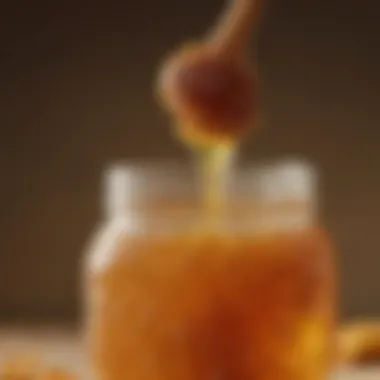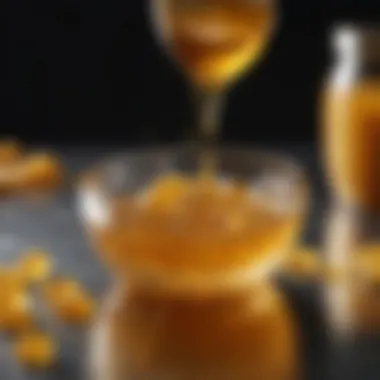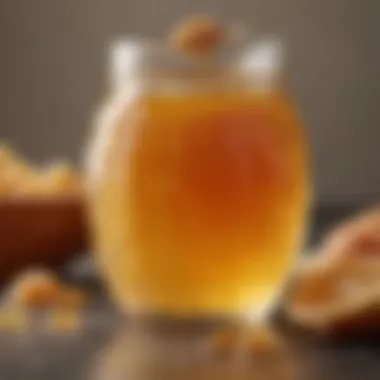Is Crystallized Honey Bad? Debunking Myths and Facts


Intro
Crystallized honey, also known as granulated or solidified honey, is a natural process that occurs when glucose converts into crystals. Many consumers have a misunderstanding about crystallized honey, often equating it with inferior quality. Despite this, crystallization is a common phenomenon that can affect any type of honey. This article seeks to clarify the misconceptions surrounding crystallized honey, assessing both its safety and nutritional value.
Honey can undergo crystallization due to various factors, such as nectar source, storage conditions, and the ratio of glucose to fructose in the honey itself. In this exploration, we will discuss how crystallized honey is not harmful and can actually retain its nutritional benefits. By addressing common doubts and providing insights into acceptable practices for storing honey, we aim to offer a complete understanding of crystallized honey's place in both culinary and health contexts.
As we move forward, expect to discover best storage methods, industry perspectives, and expert opinions on the gastronomic potential of crystallized honey. Through this comprehensive evaluation, readers will find clarity on whether crystallized honey should be viewed as a problem or a versatile ingredient in their kitchens.
Understanding Honey Composition
Understanding honey composition is crucial in evaluating crystallized honey. It sheds light on the very nature of honey, including its nutritional, chemical, and floral characteristics. Knowledge of these elements helps to demystify crystallization and its implications for honey's quality and safety.
Honey is a natural sweet substance produced by bees. The process begins with the collection of nectar from flowers, which is enzymatically transformed into honey by the bees. This transformation involves complex biochemical activities, making the composition of honey diverse yet specific.
What is Honey?
Honey is primarily made up of sugars, mainly glucose and fructose, along with water, minerals, vitamins, and enzymes. Its flavor and aroma derive from the types of nectar collected, leading to variations in taste and color. The diverse types of honey reflect the geographical and botanical landscape from which they originate, making each type unique.
Honey's Chemical Structure
The chemical structure of honey is essential to understand its behavior, such as crystallization. Honey typically contains about 80% sugars, with fructose being the most abundant. The remaining percentage is mostly water, along with small amounts of proteins, vitamins, and minerals. The relative proportions of glucose and fructose play a significant role in the tendency of honey to crystallize. High fructose levels lead to slower crystallization, while excess glucose tends to promote it.
Types of Honey
Different types of honey can influence crystallization rates and quality. The two main categories are monofloral honey and polyfloral honey, each with distinct properties.
Monofloral Honey
Monofloral honey is derived from the nectar of one specific type of flower. This purity lends it a unique flavor profile and aroma, making it popular among consumers who seek specific tastes. A well-known example is Manuka honey, which is highly regarded for its potential health benefits. Its consistency and quality are often stable, although crystallization can still occur depending on its sugar content and storage conditions. This honey type's distinctive qualities contribute positively to the discussion of crystallized honey, as they often maintain high nutritional value even when crystallized.
Polyfloral Honey
Polyfloral honey, in contrast, is made from nectar collected from multiple flower sources. This results in a more complex flavor, which can vary seasonally and geographically. While polyfloral honey can be less predictable in terms of taste and texture, it tends to have a broader spectrum of nutrients due to the diversity of flowers involved. The variability in sugar composition among different flowers affects how quickly or slowly the honey may crystallize. Its varied characteristics make polyfloral honey an interesting subject when discussing the aspects of crystallized honey and its market acceptance.
Overall, understanding the composition of honey and the types available is vital in forming a complete perspective on whether crystallization is detrimental or beneficial. This section serves as a foundation for exploring the subsequent aspects of crystallized honey.
What is Crystallization?


Crystallization is an essential phenomenon in the realm of honey that warrants in-depth exploration. Understanding crystallization is crucial for discerning the quality and safety of honey. This topic impacts both consumers and producers, as it influences the perception of honey's edibility and its culinary uses. Recognizing the factors and implications surrounding crystallization can foster better decision-making regarding honey consumption and usage.
Definition of Crystallization
Crystallization refers to the process by which honey transforms from a liquid state to a solid state, forming granules or crystalline structures. This transformation typically occurs when the glucose in honey begins to separate from the water content. Though it may seem undesirable at first glance, crystallization is a natural occurrence that reflects the inherent properties of honey. It does not mean that the honey has gone bad or lost its nutritional value. Crystallized honey, in fact, retains the same flavor profile and health benefits as its liquid counterpart.
Causes of Crystallization
Several factors contribute to the crystallization of honey, the most significant being its composition and environmental influences. Understanding these causes is vital in evaluating the quality and characteristics of honey.
Glucose and Fructose Ratios
The ratio of glucose to fructose in honey is a key factor influencing crystallization. Honey typically contains varying amounts of glucose and fructose, where glucose is more prone to crystallizing. When honey has a higher glucose concentration, it is likely to crystallize faster. Therefore, honeys that are rich in glucose, like clover honey, have a higher tendency to form crystals compared to those with more fructose, such as acacia honey. This characteristic can be beneficial, as it indicates the purity of honey; pure honey is more prone to crystallization. However, this may also lead to concerns for consumers who prefer liquid honey.
Environmental Factors
Environmental conditions play a significant role in the crystallization process of honey. Variables such as temperature and humidity should be considered. When honey is exposed to cooler temperatures, it increases the likelihood of crystallization. Higher temperatures tend to keep honey in its liquid state longer. Additionally, if honey is stored in a humid environment, it can absorb moisture, potentially delaying the crystallization process. Understanding these environmental factors is essential for producers and consumers alike. It allows better control over storage conditions, ultimately preserving the intended consistency and usability of honey.
The topic of crystallized honey is often misunderstood by consumers. Many believe that once honey has crystallized, it has gone bad or lost its beneficial properties. This assumption can be misleading. In reality, crystallization is a natural process that honey undergoes due to its unique composition. It is crucial to clarify this point, as understanding crystallization can enhance our appreciation of honey.
Crystallized honey retains all its nutritional value. It continues to provide the same vitamins, minerals, and enzymes that make honey a sought-after natural product. However, some consumers may find a grainy texture unappealing. Thus, addressing the nutritional integrity of crystallized honey is essential in this discussion.
In addition to nutritional benefits, there are several considerations regarding safety and quality. Ensuring the production of high-quality honey involves careful assessment. Furthermore, how one stores honey plays an important role in its longevity. This article addresses these factors comprehensively, so the readers will gain a more balanced perspective on crystallized honey.
The Benefits of Crystallized Honey
Crystallized honey is often misunderstood, leading many to believe it is a sign of inferiority. In reality, it possesses several advantages that can enhance both its usability and culinary appeal. Understanding these benefits can reshape one's view of crystallized honey and encourage its inclusion in various recipes and diets.
Texture and Culinary Uses
Baking Applications
Crystallized honey plays an important role in baking. Its thick consistency, which comes from the crystallization process, offers unique properties. This texture allows for easier measuring and incorporation into batter or dough compared to liquid honey.
When substituting crystallized honey for liquid, bakers often find that it enhances moisture retention in baked goods. This is particularly beneficial in recipes for breads, muffins, and cakes, where a moist crumb is desirable. Additionally, the flavor intensifies as the sugars caramelize during baking. However, it is crucial to note that some recipes may require adjustments to liquid ratios to avoid overly dense results.
Spoonable Uses


Spoonable uses of crystallized honey are quite diverse, making it a versatile ingredient in the kitchen. Its spreadable nature lends itself well to applications like topping for toast, pancakes, or yogurt. The thick texture combined with its rich flavor can elevate an ordinary breakfast into something more appealing.
Furthermore, using crystallized honey allows for controlled sweetness in recipes. When spooned onto foods, it does not run off as quickly as liquid honey might; instead, it stays put, providing a sustained sweetness. This can be an advantage when looking to create layered flavors in culinary dishes. Despite these advantages, it may not dissolve as quickly in hot liquids, so users should consider this limitation during preparation.
Crystallization as a Sign of Purity
Crystallization can also be perceived as an indicator of high-quality honey. Natural honey crystallizes over time due to its sugar content and lack of preservatives, signaling that it has not been heavily processed. This can be appealing to consumers who prioritize organic and natural products in their diets.
It is vital to note that crystallized honey tends to be more nutrient-dense than its liquid counterpart. Consumers may find assurance in knowing that the crystallization process preserves many of honey's beneficial properties, including antioxidants and natural enzymes.
How to Manage Crystallization
Understanding how to manage crystallization is essential for honey lovers. While crystallized honey might be viewed as a defect by some, it can actually be managed effectively to retain its quality and usability. This section delves into decrystallization methods and best practices that can help maintain honey's desirable attributes. With proper techniques, even crystallized honey can be transformed back to its liquid state or enjoyed in its unique texture.
Decrystallizing Honey
Methods of Decrystallization
Decrystallizing honey involves a few straightforward methods that are accessible and easy to implement. One popular method is the gentle heating process, where honey is placed in a warm water bath. This method is effective because it gradually brings the honey back to its liquid form without harming its beneficial properties. A key characteristic of using warm water is that it disperses heat evenly, protecting the honey from overheating, which can degrade its enzymes and flavor. While this option is beneficial, it requires vigilance. Users must ensure not to exceed 104°F (40°C) to preserve honey's intrinsic qualities.
Another method includes using a microwave, but this approach is often less favored due to its potential to overheat honey quickly. Therefore, it is vital to use very short intervals and stir in between.
Best Practices
Implementing best practices is crucial for honey management. One important practice is to store honey in an airtight container and at stable temperatures. This is beneficial as it helps prevent moisture ingress that contributes to crystallization. Also, avoiding exposure to direct sunlight maintains the integrity of honey. Furthermore, using a glass jar is preferable. Glass does not impart any flavors and is easy to cleanse.
Having a clear labeling system for honey can also ensure that older stocks are consumed first, reducing the chances of crystallization with prolonged storage. Additionally, preferences around the texture of honey can dictate choices in application and consumption that align with how often honey is used.
Preventing Future Crystallization
Crystallization can often be avoided with the right storage techniques and awareness of the honey's natural properties. Selecting honey varieties with lower glucose content, such as acacia honey, can reduce the tendency to crystallize. Understanding how different honey types respond to storage conditions is key.
Maintaining a consistent, cool environment away from fluctuating temperatures can help ensure the honey remains liquid. Frequent temperature changes increase the speed at which honey crystals form.
Additionally, sealing the honey airtight is an effective preventive measure. By excluding air and moisture, the chances of crystallization are greatly minimized, ensuring honey remains smooth and usable for extended periods.
Staying educated about the types of honey and their characteristics can also empower consumers to make informed choices about storage and usage.


"By managing crystallization, consumers can enjoy honey in its preferred state and maintain its beneficial properties."
Consumer Perceptions and Misconceptions
Understanding consumer perceptions and misconceptions about crystallized honey is crucial for several reasons. First, these perceptions can influence purchasing behavior. If consumers believe that crystallized honey is inferior to liquid honey, they may avoid it altogether. This could lead to a skewed market, where beautifully crystallized honey is overlooked. Often, crystallization is wrongly viewed as a sign of poor quality when it is, in fact, a natural process that can occur even in high-quality honey.
Second, education is essential in helping consumers recognize that all honey, regardless of its form, retains its nutritional value. For food lovers, understanding the nuances of honey can foster a deeper appreciation for its varieties and uses. It can also reshape the way consumers view their food choices.
Misconceptions can stem from marketing strategies that maximize the appeal of liquid honey while subtly devaluing crystallized forms. As a result, this section will explore specific elements regarding honey marketing, consumer education, and perceived worth.
Marketing and Honey Labels
The marketing of honey plays a significant role in shaping public perception. Labels on honey jars often highlight the clarity of liquid honey, sometimes using terms like "pure" or "raw" that suggest the liquid form is best. In contrast, crystallized honey may be seen as "old" or "bad." This can discourage consumers from trying crystallized honey, regardless of its quality or flavor.
From the labeling perspective, terms such as "all-natural" or "local" can suggest freshness and purity, making consumers more inclined to choose liquid honey. Marketers may not educate consumers about the crystallization process and its connection to the product’s natural qualities and nutritional benefits.
Clear and informative labeling should convey crucial information about the honey’s characteristics, benefits, and its natural crystallization. For example, if crystallized honey retains a high level of antioxidants and beneficial enzymes, this should be reflected on the product’s packaging.
- Transparency is essential to build trust.
- Educational marketing strategies can bridge the knowledge gap.
- Highlighting flavor profiles could encourage trials of crystallized varieties.
Public Understanding of Honey Quality
Consumer understanding of honey quality often sits at a confusing crossroads. Many people associate the liquid state of honey with freshness and premium quality, while crystallization is misunderstood as a fault. This is a significant misconception that needs addressing.
In reality, crystallized honey offers several quality indicators. It may show that the honey is less processed and more natural, which many consumers actually prefer. Public education around crystallization could help shift these flawed perceptions.
- Nutritional Quality: Crystallized honey still holds its rich nutrient profile, including vitamins, minerals, and antioxidants.
- Taste and Aroma: Many suggest that crystallized honey imparts unique flavor characteristics that differ from its liquid counterpart.
- Natural Process: Recognizing that crystallization is a natural response that honey can undergo can help consumers shift their view.
Engaging resources such as articles from Wikipedia or discussions on platforms like Reddit can aid in providing a broader context about honey quality.
Understanding the truth about crystallized honey primarily lies in educating consumers about the benefits and natural processes behind it. By fostering a more informed audience, we can allow honey lovers to appreciate every form of honey, not just the liquid one.
Closure
Understanding crystallized honey brings important insights into both its nature and value. From the reactions that lead to crystallization to the misconceptions that surround it, the discussion offers a well-rounded perspective on why crystallization itself is not a negative attribute. It is essential for consumers and culinary enthusiasts to recognize both the safety and nutritional benefits associated with crystallized honey.
Summary of Findings
The research shows that crystallization is a natural process and occurs due to the composition of honey, chiefly due to the ratios of glucose and fructose. Nutritional aspects reveal that the nutritional value remains intact in crystallized honey, making it a viable option for consumption. Moreover, safety concerns can be addressed through proper storage practices, which can actually enhance the longevity and quality of the honey. The preferences for texture and taste can also dictate a consumer's choice, as some might prefer crystallized honey for specific culinary applications.
Final Thoughts on Crystallized Honey
In summation, while many may question whether crystallized honey is bad, the reality is quite the opposite. The crystallization phenomenon should not deter consumers. Instead, the ongoing education regarding honey types, its nutritional benefits, and safe storage conditions can help foster greater acceptance of crystallized honey in culinary practices. Embracing crystallized honey opens doors to new textures and flavors, enriching the overall honey experience. As more consumers understand these elements, the appreciation for all forms of honey—crystallized included—will likely grow.







